

Special Needs. MORE for Parents These Special Needs Factsheets explain the basics about health conditions that can affect learning in the classroom, and offer quick tips on teaching strategies to help students succeed in school.

Teaching Methods and Organisation. Teaching Special Kids: Online Resources, Special Education Curriculum. Finding strategies for working with special needs students can be a challenge for full-time special education teachers, let alone teachers who work on a part-time basis with kids facing challenges .

Education World understands the problems you face and offers online resources that can help you better understand -- and help -- students with special needs. Today, almost every classroom includes a number of students who are dealing with a disability -- either physical, educational, emotional, or a combination of all three. Special Needs – Teacher Resources.
Highlights 2016 Presidential Elections Election season is here.
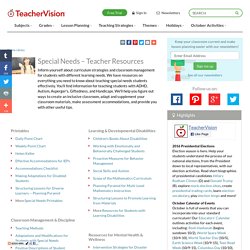
Help your students understand the process of our national elections, from the President down to local representatives, with our election activities. Read short biographies of presidential candidates Hillary Rodham Clinton (D) and Donald Trump (R), explore mock election ideas, create presidential trading cards, learn election vocabulary, play election bingo and more! October Calendar of Events October is full of events that you can incorporate into your standard curriculum! Special Education Resources and Links for Parents and Teachers.
Traumatic Brain Injury. A legacy resource from NICHCY Disability Fact Sheet 18 (FS18) Links updated, August 2014 In This Publication: Susan’s Story Susan was 7 years old when she was hit by a car while riding her bike.
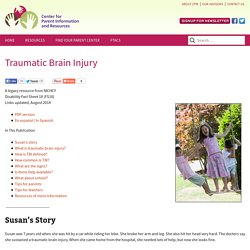
She broke her arm and leg. In fact, that’s part of the problem, especially at school. Back to top. Resources for People with Traumatic Brain Injury (TBI) - BrainLine.org. “I’m not me anymore, but I’m still me.”
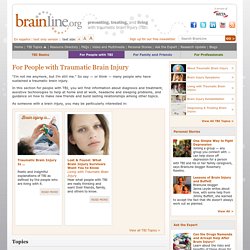
So say — or think — many people who have sustained a traumatic brain injury. In this section for people with TBI, you will find information about diagnosis and treatment, assistive technologies to help at home and at work, headache and sleeping problems, and guidance on how to make new friends and build lasting relationships among other topics. As someone with a brain injury, you may be particularly interested in: Topics About Traumatic Brain Injury Any injury to the brain from an external force is a TBI. Populat. PDF Version A brief introduction to the major disability groups and some specific barriers to accessibility they encounter A significant portion of our population (over thirty million in the U.S.)1 has impairments which reduce their ability to effectively or safely use standard consumer products.
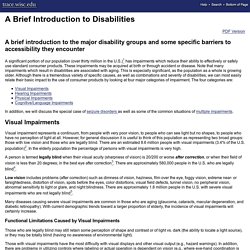
These impairments may be acquired at birth or through accident or disease. Deafness and hearing loss. Child Speech and Language. Physical disability. Spina; bifida; cerebral; palsy; muscular; dystrophy; hydrocephalus; brain; injury; spinal; hemiplegia; diplegia; quadriplegia; ataxia; physiotherapist; speech; pathologist; occupational; therapist; genetic; counsellor; dystrophies; physical; disability; Duchenne; genetic; congenital; spinabifida ; In the early years, children may have some difficulties in learning to move skilfully.
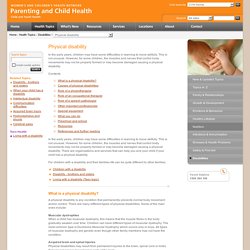
This is not unusual. Services for Children with an Emotional Behavioral Disability. Eligibility The term "emotional disturbance" (ED) was changed to "emotional behavioral disability" (EBD) effective July 1, 2001.
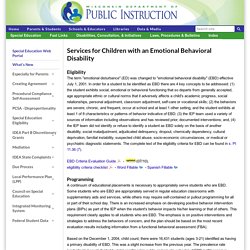
EBD Criteria Evaluation Guide - (07/10).eligibility criteria checklist - Word Fillable - Spanish Fillable Programming A continuum of educational placements is necessary to appropriately serve students who are EBD. Based on the December 1, 2004, child count, there were 16,431 students (ages 3-21) identified as having a primary disability of EBD. Training. Emotional/Behavioral Disorders. Emotional disturbance (ED, here called emotional or behavioral disorder or EBD) is one of the categories of disability included under the Individuals with Disabilities Education Improvement Act, also known as IDEA, 2004.
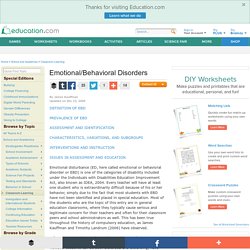
Every teacher will have at least one student who is extraordinarily difficult because of his or her behavior, simply due to the fact that most students with EBD have not been identified and placed in special education. Most of the students who are the topic of this entry are in general education classrooms, where they typically cause serious and legitimate concern for their teachers and often for their classroom peers and school administrators as well. This has been true throughout the history of compulsory education, as James Kauffman and Timothy Landrum (2006) have observed. A frequent misunderstanding is that students with EBD are just chronically difficult—irritating to teachers but not really disabled. According to the U.S. What Is Autism? Autism, or autism spectrum disorder (ASD), refers to a broad range of conditions characterized by challenges with social skills, repetitive behaviors, speech and nonverbal communication.
According to the Centers for Disease Control, autism affects an estimated 1 in 59 children in the United States today. We know that there is not one autism but many subtypes, most influenced by a combination of genetic and environmental factors. Because autism is a spectrum disorder, each person with autism has a distinct set of strengths and challenges. The ways in which people with autism learn, think and problem-solve can range from highly skilled to severely challenged. Some people with ASD may require significant support in their daily lives, while others may need less support and, in some cases, live entirely independently.
Indicators of autism usually appear by age 2 or 3. Autism Society of Wisconsin - ASW. Intellectual and Developmental Disabilities (IDDs): Condition Information. Skip sharing on social media links Intellectual and developmental disabilities (IDDs) are disorders that are usually present at birth and that negatively affect the trajectory of the individual’s physical, intellectual, and/or emotional development.

Many of these conditions affect multiple body parts or systems. Intellectual disability1 starts any time before a child turns 18 and is characterized by problems with both: Cognitive Disabilities Information. Defining cognitive disability is not easy, and definitions of cognitive disability are usually broad. Persons with cognitive disabilities may have difficulty with various types of mental tasks. Learning Disabilities In Children Can Be A Challenge At Home & School. Learning disabilities are present in at least 10 percent of the population. By following the links on this page you will discover many interesting facts about learning disabilities as well as uncover some of the myths. You will also be provided with practical solutions to help children and adolescents with learning disabilities greatly improve their academic achievement as well as their self-esteem.
What is a learning disability? Interestingly, there is no clear and widely accepted definition of “learning disabilities.” Because of the multidisciplinary nature of the field, there is ongoing debate on the issue of definition, and there are currently at least 12 definitions that appear in the professional literature. SFCD Homepage. WI FACETS. Penfield Children's Center. Learning Disabilites - Helpguide.org. Learning disabilities create challenges for both you and your child–but they are not insurmountable. These articles can help you better understand your child's needs and support you in helping him or her succeed in school and in life. Learning disabilities affect how a child understands, processes, and responds to new information.
Not only do they interfere with school and learning, but they can also contribute to emotional problems. However, having a learning disability doesn't mean that your child can't do well in life. Smart KidsSmart Kids.